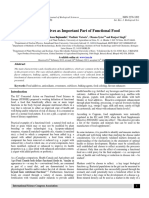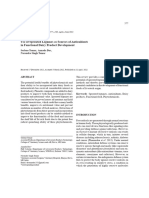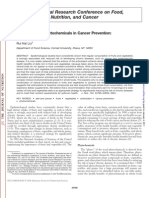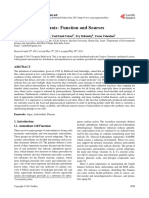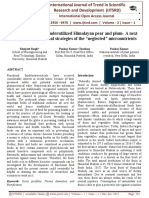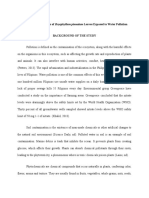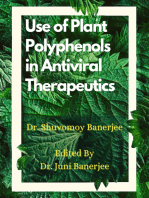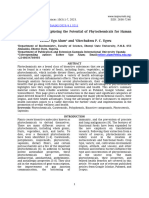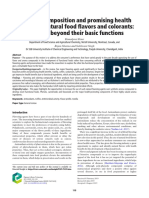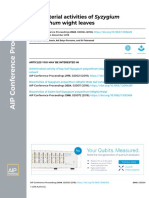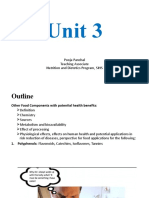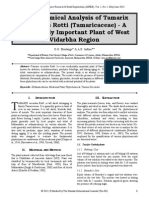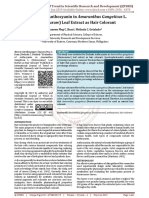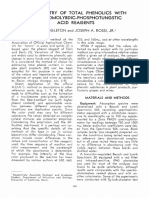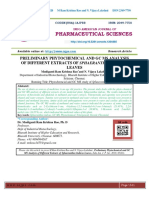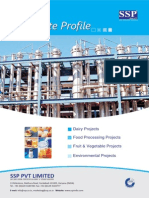Professional Documents
Culture Documents
Fruit of The Pomegranate (Punica Granatum) Plant: Nutrients, Phytochemical Composition and Antioxidant Activity of Fresh and Dried Fruits
Fruit of The Pomegranate (Punica Granatum) Plant: Nutrients, Phytochemical Composition and Antioxidant Activity of Fresh and Dried Fruits
Original Title
Copyright
Available Formats
Share this document
Did you find this document useful?
Is this content inappropriate?
Report this DocumentCopyright:
Available Formats
Fruit of The Pomegranate (Punica Granatum) Plant: Nutrients, Phytochemical Composition and Antioxidant Activity of Fresh and Dried Fruits
Fruit of The Pomegranate (Punica Granatum) Plant: Nutrients, Phytochemical Composition and Antioxidant Activity of Fresh and Dried Fruits
Copyright:
Available Formats
Volume 9, Issue 4, April – 2024 International Journal of Innovative Science and Research Technology
ISSN No:-2456-2165 https://doi.org/10.38124/ijisrt/IJISRT24APR453
Fruit of the Pomegranate (Punica granatum) Plant:
Nutrients, Phytochemical Composition and
Antioxidant Activity of Fresh and Dried Fruits
Induja E1; Dr. Jancy Rani D2
M.Sc. Food and Nutrition1, Assistant Professor2
Dept. of Food Science and Nutrition, Dr. N.G.P Arts and Science College, Coimbatore.
Abstract:- Since the beginning of time, medicinal plants I. INTRODUCTION
have been considered nature's undiscovered but precious
resources, or nature's pharmacy. Almost 35,000 different Humans have struggled with a variety of illnesses,
species have been used as a safe and effective source of discomforts, and ways to provoke them over the years. The
medicine in nearly every human culture on the planet use of medicinal plants to cure a variety of diseases is one of
(representing over 75% of the global population). The the many strategies used to combat illnesses. The trend
body uses plant-based materials known as nutrients to aid toward herbal medicine is gaining traction despite the
in tissue development and repair. A natural defense introduction of several key medicines because of growing
mechanism against disease, phytochemicals are bioactive worries about the growing toxicities associated with main line
compounds that are present in fruits, vegetables and therapies. Using medicinal plants in conjunction with other
aromatic plants. Phytochemicals are a broad class of forms of treatment is now regarded as a complementary and
chemical substances present in natural goods. These alternative therapy (Khalid et al., 2022).
include polyphenols, flavonoids, steroidal saponins,
organo-sulfur compounds etc. Numerous biological The rapid therapeutic benefits of synthetic drugs
advantages of natural antioxidants include their ability to propelled allopathic medical systems to popularity at the start
reduce inflammation, prevent atherosclerosis and fight of the 20th century, but regrettably, they also came with a host
cancer. Pomegranate have also been investigated in recent of unfavorable side effects. This is causing a trend in the
years to determine the presence of certain existing healthcare system to change from synthetic to herbal.
phytoconstituents. Pomegranate has a wide range of The "Return to Nature" movement is the name given to it.
pharmacological properties, including anti- Plant-based natural medicines have a wide range of
inflammatory, wound-healing, antidiabetic, antioxidant, phytochemicals and essential oils, which suggests that they
anti-cancer, anti-mutagenic, anti-microbial properties. have therapeutic potential for humans (Sharma et al., 2014).
Hence the objectives of this present study is to analyse the
nutrient composition, to identify the phytochemicals, to According to data released by the United Nations Food
estimate the antioxidant activity of the fresh and dried and Agriculture Organization, fruit output has been
pomegranate fruits. Nutrients such as carbohydrate, increasing consistently over the past few decades. However,
protein, fibre, iron, vitamin-c, calcium were done by with the growing global population and current consumer
AOAC method. Preliminary qualitative phytochemical preferences for organic, high-quality food products and a
analysis was carried out by the standard methodology healthy lifestyle, the amount of fruits produced cannot meet
with extraction through maceration process to identify the world's needs for the greatest food. Furthermore, a
the secondary metabolites like alkaloids, flavonoids, significant amount of by-products will inevitably be produced
quinones and etc in various solvents like aqueous, ethanol, as fruit output rises. Precup et al., (2022) suggest that
methanol, acetone, petroleumether and chloroform. incorporating these by-products into functional foods is a
Antioxidant activity were done by DPPH method. Hence viable way to decrease waste production and improve the
dried fruit have better profile of phytochemicals and nutritional value of various diets.
antioxidants so it can be used for therapeutic purposes
mainly digestive problems and pharmaceutical industries. A significant amount of scientific evidence indicates
that eating fruits and vegetables and other plant foods can
Keywords:- Medicinal Plants, Defense System, Bioactive help prevent chronic diseases, which supports the idea that
Compounds, Antioxidants, Pharmaceutical these foods should be an essential part of a balanced diet. A
wide variety of chemical compounds, particularly secondary
metabolites with a polyphenolic character, are found in fruits
and vegetables. These chemical compounds, which include
ascorbic acid, carotenoids, and polyphenols like flavonoids
and phenolic acids, have advantageous biological and
antioxidant action that is significant to humans. Furthermore,
IJISRT24APR453 www.ijisrt.com 369
Volume 9, Issue 4, April – 2024 International Journal of Innovative Science and Research Technology
ISSN No:-2456-2165 https://doi.org/10.38124/ijisrt/IJISRT24APR453
these compounds create easily excretable weak radicals and compounds that promote health. They also have anti-diabetic,
halt fast-moving oxidative processes (Torralba et al., 2018). anti-carcinogenic activity and improve urinary health. Hence
it is selected for the present study for due to the presence of
These days, pomegranates are reported to have bioactive compounds and therapeutic purposes.
therapeutic benefits for a wide range of illnesses and
conditions, such as obesity, diabetes, aging, and B. Processing of Fresh and Dried Fruits:
inflammation, in international literature. In particular, it has The sample was first visually examined for any kind of
been demonstrated that treating obesity using pomegranate- infection, spores, damage, discoloration, and distortion.
derived natural chemicals is effective (Viladomiu et al., Undamaged samples of fruits were collected, grinded and
2013). filter to get extract. Natural shade drying is the most accepted
storage method for aromatic medicinal herbs because of
Pomegranates contain a variety of bioactive its low cost and minimum loss of volatile constituents. So the
components, including secondary metabolites like tannins, fruits are shadow dried for 3-4 days, collected & then grinded
organic acids, phenolic acids (including gallic acid, ellagic into a fine powder and stored in a air tight container.
acid (EA), and caffeic acid), anthocyanins, flavonoids,
vitamins, and terpenes, in addition to primary metabolites like
sugars, lipides, and fatty acids. However, tannins, such as
gallotannins and ellagitannins, appear to be the primary
secondary metabolites (Vucic et al., 2019).
Pomegranates have a unique biochemical profile with
over 124 phytochemicals that provide them a wide spectrum
of anti-inflammatory, anti-oxidant, and anti-mutagenic
effects. High molecular weight hydrolysable tannins, such as
ellagitannins, a variety of anthocyanins that protect against
degenerative diseases, hydroxybenzoic acids,
hydroxycinnamic acids, minerals, vital lipids, and complex
polysaccharides, are thought to be stored in pomegranate fruit
and its fractions, such as the flower, peel, juicy sacs, and Fig 1: Cut it into Two Halves
seeds. It typically has a pH of less than 4.0 and contains 70–
180 g/L of sugar, mostly glucose and fructose. According to
Orgil et al., (2014), the fruit's edible portion is composed of
85% water, sugars, pectin, organic acids, phenolics, and
flavonoids, mostly anthocyanins.
Thus, the goal of this research is to determine the
amount of free radical scavenging activity in both fresh and
dried pomegranate fruits, as well as to analyze nutrients and
screen for phytochemicals. Hence the present study is carried
out by following objectives are to analyse the nutrient
composition of fresh and dried pomegranate fruits, to analyse
the phytochemical composition of fresh and dried
pomegranate fruits, to estimate the antioxidant activity of
fresh and dried pomegranate fruits.
Fig 2: Fresh Pomegranate
II. MATERIALS AND METHODS
A. Selection and Collection of Leaves:
The pomegranate fruit is berry-like with a leathery rind
(or husk) enclosing many seeds surrounded by the juicy arils,
which comprise the edible portion of the fruit. The aril juice
sack is composed of many epidermal cells. According to
cultivar, arils range from deep red to virtually colorless,
whereas the enclosed seed varies in content of sclerenchyma
tissue, which affects seed softness. Pomegranate is full of
powerful antioxidants like anthocyanins, tannins and
punicalagin. These elements are known to be powerful
antioxidants to reduce inflammation and prevent chronic
health issues. Pomegranates can have up to three times
more antioxidants than green tea or red wine. They provide
plenty of macro- and micronutrients, as well as bioactive Fig 3: Shadow Drying
IJISRT24APR453 www.ijisrt.com 370
Volume 9, Issue 4, April – 2024 International Journal of Innovative Science and Research Technology
ISSN No:-2456-2165 https://doi.org/10.38124/ijisrt/IJISRT24APR453
Extraction Process – Maceration:
Maceration is the process of placing coarsely crushed
drug material—such as leaves, stem bark, or root bark—into
a container and pouring menstrual fluid over it until the drug
material is completely covered. Following that, the container
is sealed and left for at least three days. If the material is
stored in a bottle, it is shaken and mixed on a regular basis to
ensure complete extraction. After extraction, the micelle and
mark are separated via decantation or filtration. The micelle
is next evaporated in an oven or over a water bath to separate
it from the menstruum. This method is practical and suitable
for materials that are thermostable in plants (Abubakar et al.,
2020).
Fig 4: Fine Pomegranate Powder
The extraction was done with different solvents such as
aqueous, methanol, ethanol, chloroform, petroleum ether,
C. Extraction of Fresh and Dried Pomegranate Fruits: acetone for phytochemical analysis. For antioxidant and
Extraction is the first step in isolating the desired natural nutrient analysis the extract was done with aqueous solvent.
compounds from the basic materials. The extraction principle
states that pressing, sublimation, distillation, and solvent D. Determination of Nutrient Analysis of Fresh and Dried
extraction are examples of extraction procedures. The solvent Pomegranate Fruits:
extraction method is the most widely used strategy. The nutritional analysis is the description of the method
used to determine the amounts of the nutrients in a particular
food. The extraction was carried out by aqueous solvent.
Table 1: Nutrient Analysis in Aqueous Extract
Nutrients Method Author & Year
Carbohydrate Anthrone reagent method E.E.Layne, (1975), David T. Plummer (1990)
Protein Lowry’s method Chang-Hui Shen (2023)
Crude Fibre Weende method D. O. Holst (1982)
Vitamin-c Titration method Earle Willard Mchenry and Murray Graham (1935)
Iron Colorimetric method Braunschweig (2012)
Calcium Titration method Kahandal S (2017)
E. Qualitative Phytochemical Analysis: flavonoids, phenol and steroids were analysed by standard
The presence of various phytochemicals in fresh and procedures with different solvents as mentioned above.
dried Pomegranate fruits were analyzed. Phytochemical such Qualitative Phytochemical screening procedure is given
as alkaloids, saponin, tannin, terpenoids, quinones, below:
Table 2: Qualitative Phytochemical Analysis in Various Solvent Extract
Phytochemicals Procedure Observation
Alkaloids (Wagner test) 2ml extract, 2 to 3drops of Fecl Greenish to black color indicates the presence of alkaloids
Flavonoids (Alkaline reagent 2ml extract +Few Intense yellow color which become colorless onaddition of
test) drops of NaOHsolution dil Hcl
Phenol 2ml extract +5%Fecl Deep blue or green color
(Ferric chloride test) indicates presence of phenol
Saponins (Foaming test) 2ml extract +6ml distilled Staple foam indicates thepresence of saponins
H2O and shakevigorously
Tannins (Braymers test) 2ml extract + Alcoholic Fecl3 Blue or green colour indicates the presence of
tannins
Terpenoids 1ml chloroform+2mlextract+few Reddish brown precipitateindicates presence of
drops C.H2SO4 terpenoids
Quinone 2ml extract +con HCL Yellow precipitate indicates
the presence of quinone
Steroids 2ml extract +chloroform +H2SO4 Development of reddish
(Salkowski test) brown colour indicates thepresence of steroids
IJISRT24APR453 www.ijisrt.com 371
Volume 9, Issue 4, April – 2024 International Journal of Innovative Science and Research Technology
ISSN No:-2456-2165 https://doi.org/10.38124/ijisrt/IJISRT24APR453
F. Estimation of Antioxidant Activity of Fresh and Dried 2,2-Diphenyl-1-picrylhydrazyl (DPPH) Radical
Pomegranate Fruits: Scavenging Assay:
Antioxidants are compounds that minimize oxidative DPPH is a stable deep purple chromogen radical. It is
damage to biological processes by giving free radicals an not required to be generated prior to the test and can be
electron and making them appear harmless (Shantabi et al., purchased commercially. In order to eliminate DPPH
2014). Antioxidant compounds can scavenge free radicals radicals, the DPPH scavenging assay depends on
and prolong shelf life by postponing the lipid peroxidation antioxidants’ capacity to contribute electrons. The reaction
process, which is one of the primary causes of food and causes a change in the color of DPPH, which is visible at 517
pharmaceutical product deterioration during processing and nm. This discoloration can be used to determine how efficient
storage (Halliwell 1997). The antioxidant activity of fresh and the antioxidants are.
dried pomegranate fruits was assessed using the DPPH
radical scavenging test (DPPH) In a test tube, 100 µL of leaf extract and 3 mL of DPPH
working solutions were combined. Three milliliters of DPPH-
containing solution in 100 µL of methanol is a typical
standard. After then, the tubes were kept completely dark for
thirty minutes. Therefore, the absorbance was calculated at
517 nm.
% Scavenging Activity = Absorbance of the control – Absorbance of the sample ×100
Absorbance of the control
III. RESULTS AND DISCUSSION
Table 3: Nutrient Analysis of Fresh and Dried Pomegranate Fruits
Nutrients Fresh Pomegranate fruits Dried Pomegranate fruits
Carbohydrate 0.60g 0.42g
Protein 23g 16.5g
Crude Fibre 5.55% 7.4%
Vitamin-C 22mcg 17.6mcg
Iron 50mg 100mg
Calcium 3.6mg 5.6mg
Table - 3 depicts the nutrient analysis of the fresh and amount compared to dried fruits while in fibre, iron &
dried pomegranate with aqueous extract. Carbohydrate, calcium are present in dried fruits are higher in amount when
protein & vitamin-c present in fresh fruits are higher in compared to fresh fruits.
Table 4: Qualitative Phytochemical Analysis of Fresh and Dried Pomegranate fruits in Various Solvents
Aqueous Ethanol Methanol Acetone Petroleum Ether Chloroform
Phytochemicals Fresh Dried Fresh Dried Fresh Dried Fresh Dried Fresh Dried Fresh Dried
Alkaloids - - + + + + + - - + - -
Flavonoids + + + + + + + + - + - +
Phenols + + + + + + + + - - + +
Saponins - + + - + + + + + + + -
Tannins + + + + + + + + - + - +
Terpenoids - - - + - + - - - - + +
Quinones - - - + - - - + + + - -
Steroids + + + + + + + - + + + +
Table – 4 depicts the qualitative phytochemical analysis Methanol extract of fresh fruits contain all
of fresh and dried pomegranate fruits with various solvent phytochemicals except terpenoids & quinones while in dried
extract. Aqueous extract of fresh fruits reveals that it contains fruits contains all phytochemicals except quinones
flavonoids, phenols, tannins and steroids while in dried fruits
contains phytochemicals such as flavonoids, phenols, Acetone extract of fresh fruits contains all
saponins, tannins and steroids except alkaloids, terpenoids phytochemicals except terpenoids and quinones while in
and quinones. dried fruits contains phytochemicals such as flavonoids,
phenols, saponins, tannins & quinones.
Ethanol extract of fresh fruits contains all
phytochemicals except terpenoids & quinones while in dried Petroleum ether of fresh fruits contain saponins,
fruits contains all phytochemicals except saponins. quinones and steroids while in dried fruits contains most of
the phytochemicals except phenols & terpenoids.
IJISRT24APR453 www.ijisrt.com 372
Volume 9, Issue 4, April – 2024 International Journal of Innovative Science and Research Technology
ISSN No:-2456-2165 https://doi.org/10.38124/ijisrt/IJISRT24APR453
Chloroform extract of fresh fruits contains phenol, Majority of the tested phytochemical were present in all
saponins, terpenoids and steroids while in dried fruits solvent extract of the dried fruits.
contains all phytochemicals except saponin and quinones.
Fig 5: Aqueous Extract Fig 6: Ethanol Extract
Fig 7: Methanol Extract Fig 8: Acetone Extract
Fig 9: Petroleum Ether Extract Fig 10: Chloroform Extract
Table 5: Antioxidant Activity of Fresh and Dried Pomegranate Fruits
Concentration(µg/ml) Absorption % of inhibition
100 Fresh Dried Fresh Dried
200 4.131 3.101 9.00 31.69
300 4.068 2.123 10.03 52.85
400 3.154 1.839 30.26 59.34
500 2.123 0.356 53.47 92.19
IJISRT24APR453 www.ijisrt.com 373
Volume 9, Issue 4, April – 2024 International Journal of Innovative Science and Research Technology
ISSN No:-2456-2165 https://doi.org/10.38124/ijisrt/IJISRT24APR453
Table – 5 depicts the antioxidant activity of fresh and contain more antioxidant than the fresh leaves (9.00%,
dried pomegranate fruits. DPPH radical scavenging assay in 10.03%, 30.26%, 53.47%, 55.17%).
dried fruits (31.69%, 52.85%, 59.34%, 92.19%, 93.24%)
Fig. 11: Fresh Fruit Fig 12: Dried Fruit
IV. CONCLUSION [5]. Viladomiu M, Hontecillas R, Lu P, Bassaganya-Riera
J. (2013). “Preventive and prophylactic mechanisms
The pomegranate (Punica granatum) is the most valued of action of pomegranate bioactive constituents.”
and well-known plant in the Ayurvedic medical system. It is Evid. Based Complement. Altern. Med, 789764.
one of the most versatile plants and has several medicinal [6]. Orgil O, Schwartz E, Baruch L, Matityahu I, Mahajna
applications. Fruits have unique medicinal qualities because J, Amir R.(2014). “The antioxidative and anti-
of their vitamins, minerals, antioxidants, and phytochemicals. proliferative potential of non-edible organs of the
The fruits of pomegranate are potent of antioxidants and rich pomegranate fruit and tree.” LWT-Food Sci Technol,
in vitamins & minerals. Pomegranates can help to lowering 58:571– 577.
the blood pressure as well as the blood glucose levels, anti- [7]. Sharma V, Kumawat T.K, Seth R, and Sharma, A,
cancer, wound healing properties. The present study revealed (2014). “A Review on Anti-dermatophytic Efficiency
that the nutrients like carbohydrate, protein & vitamin-c are of Plant Essential Oils.” Int. J. Pure App. Biosci, 2(6),
rich in fresh fruits while fibre, calcium and iron are rich in 265-278.
dried fruits. Dried pomegranate fruits have major [8]. Halliwell B (1997). “Antioxidants in human health
phytochemical constituent in most of all solvent extraction and disease.” Ann Rev Nut, 16:33–50.
than fresh pomegranate fruits. Antioxidant activity are high [9]. E.E.Layne, (1975). “Methods in Enzymology.” 3:447.
in dried fruits compared to fresh fruits. Using pomegranate in [10]. David T. Plummer. (1990). “An Introduction to
food industry & pharmacology can address the growing Practical Biochemistry,” 179 Third Edition.
demand for nutraceuticals and functional foods. Products [11]. Chang-Hui Shen. (2023). “Quantification and analysis
made from dried samples would have a higher nutritional of proteins.” Diagnostic Molecular Biology (Second
profile than those made from fresh samples. Edition), 231-257.
[12]. Earle Willard Mchenry and Murray Graham. (1935).
REFERENCES “Observations on the estimation of ascorbic acid by
titration.” 28th June.
[1]. Khalid W, Arshad M. S, Aslam N, Mukhtar S, Rahim [13]. Braunschweig J, Bosch J, Heister K, Kuebeck C,
M. A, Ranjha M. M. A. N, Noreen S, Afzal M. F, Aziz Meckenstock RU. (2012). “Reevaluation of
A, Awuchi C. G. (2022). “Food Applications of colorimetric iron determination methods commonly
Sorghum Derived Kafirins Potentially Valuable in used in geomicrobiology.” Journal of Microbiological
Celiac Disease.” Int. J. Food Prop, 25(1), 2348–2363. Methods, 89(1):41–48.
[2]. Precup G, Teleky B.-E, Ranga F, Vodnar D.C. (2022). [14]. D. O. Holst, (1982). J. Assoc. Off. Anal. Chem,
“Assessment of Physicochemical and Rheological 65(2):265-269.
Properties of XyloOligosaccharides and Glucose- [15]. Shantabi L, Jagetia G.C, Ali M.A, Singh T.T, Devi
Enriched Doughs Fermented with BB-12.” Biology, S.V. (2014). “Antioxidant potential of Croton
11, 10836. caudatus leaf extract in vitro.” Transl. Med.
[3]. Vuˇci´c V, Grabež M, Trchounian A, Arsi´c A. (2019). Biotechnol, 2:1–15.
“Composition and potential health benefits of [16]. Kahandal S. S, Maliekal P. J, Samani, A. A, Ansari, S,
pomegranate: A review.” Curr. Pharm. Des, 25, Mapkar, S, Singh, S, & Saha M. (2017). “CALCIUM
1817–1827. ESTIMATION OF FENUGREEK LEAVES AND
[4]. Ruiz-Torralba E, Guerra-Hernández B, García- SEEDS BY VARIOUS ESTIMATION
Villanova. (2018). “Antioxidant capacity, polyphenol METHODS.” Emerging Technologies for Sustainable
content and contribution to dietary intake of 52 fruits Agriculture, 113.
sold in Spain.” CyTA –J Food, 16 (1): 1131-1138.
IJISRT24APR453 www.ijisrt.com 374
You might also like
- Netting Materials For Fishing Gear - KlustDocument193 pagesNetting Materials For Fishing Gear - KlustTiago Catuxo67% (3)
- Pharmacognosy Test Bank. 1Document15 pagesPharmacognosy Test Bank. 1OHainah MdmNo ratings yet
- Nutraceuticals and FlavonoidsDocument7 pagesNutraceuticals and FlavonoidsAnnaNo ratings yet
- MORINDA CITRIFOLIA L. (Noni) - A Review of The Scientific Validation For Its Nutritional and Therapeutic PropertiesDocument15 pagesMORINDA CITRIFOLIA L. (Noni) - A Review of The Scientific Validation For Its Nutritional and Therapeutic PropertiesDiannokaIhzaGanung100% (1)
- Food Science Nutrition - 2023 - EjazDocument19 pagesFood Science Nutrition - 2023 - EjazjuniartiyudhaNo ratings yet
- NutraceuticalDocument23 pagesNutraceuticalRina WijayantiNo ratings yet
- Food Additives As Important Part of FuncDocument13 pagesFood Additives As Important Part of FuncDerick BrooksNo ratings yet
- Struktur Dasar FlavoDocument9 pagesStruktur Dasar FlavoYuki XuNo ratings yet
- Current Research in Agricultural and FooDocument15 pagesCurrent Research in Agricultural and FooLili BujorNo ratings yet
- Ijpsr 2019 Re 27851Document9 pagesIjpsr 2019 Re 27851Muhammad daniel arrifqiNo ratings yet
- Phytochemicals and Antioxidant Activities of Aloe Vera (Aloe Barbadensis)Document12 pagesPhytochemicals and Antioxidant Activities of Aloe Vera (Aloe Barbadensis)Journal of Nutritional Science and Healthy DietNo ratings yet
- By-Products of Fruits Processing As A Source of PhytochemicalsDocument12 pagesBy-Products of Fruits Processing As A Source of PhytochemicalsshyamNo ratings yet
- Kelvin Project EditedDocument47 pagesKelvin Project EditedIgwe IfesinachiNo ratings yet
- Fruit Peels: Food Waste As A Valuable Source of Bioactive Natural Products For Drug DiscoveryDocument35 pagesFruit Peels: Food Waste As A Valuable Source of Bioactive Natural Products For Drug DiscoveryBalaa WalaaNo ratings yet
- Eggppant 1Document13 pagesEggppant 1UauahaNo ratings yet
- 2022 NullDocument7 pages2022 Nullahmedshokry591999No ratings yet
- International Research Conference On Food, Nutrition, and CancerDocument7 pagesInternational Research Conference On Food, Nutrition, and CancersahirbuleNo ratings yet
- J Sci Food Agric - 2000 - Dillard - Phytochemicals Nutraceuticals and Human HealthDocument13 pagesJ Sci Food Agric - 2000 - Dillard - Phytochemicals Nutraceuticals and Human Healthyaseena6No ratings yet
- Phytochemical Composition and Antioxidant Activity of Fresh and Dried Grape (Vitis Vinifera) Fruit ProportionsDocument6 pagesPhytochemical Composition and Antioxidant Activity of Fresh and Dried Grape (Vitis Vinifera) Fruit ProportionsInternational Journal of Innovative Science and Research TechnologyNo ratings yet
- 90Document11 pages90Eka Nurul HayatiNo ratings yet
- Phytochemistry PaperDocument15 pagesPhytochemistry PaperkundagolNo ratings yet
- Original Article: Popioana@usamvcluj - Ro Tudor - Salagean@usamvcluj - Ro Antonia - Odagiu@usamvclujDocument7 pagesOriginal Article: Popioana@usamvcluj - Ro Tudor - Salagean@usamvcluj - Ro Antonia - Odagiu@usamvclujMtc Usamv Cluj-NapocaNo ratings yet
- Feli Thesis Draft 1Document36 pagesFeli Thesis Draft 1Henry TagumaNo ratings yet
- Foods 11 02027Document15 pagesFoods 11 02027Mẫn ThyNo ratings yet
- Comparative Free Radical Scavenging Potentials of Different Parts ofDocument6 pagesComparative Free Radical Scavenging Potentials of Different Parts ofTito saragihNo ratings yet
- Comparative Free Radical Scavenging Potentials of Different Parts ofDocument6 pagesComparative Free Radical Scavenging Potentials of Different Parts ofTito saragihNo ratings yet
- Algae A Potent Antioxidant SourceDocument10 pagesAlgae A Potent Antioxidant SourceAyu SyuhadaNo ratings yet
- cOMPILE FinalDocument46 pagescOMPILE FinalememcoinactionNo ratings yet
- A Review of Phytochemicals and Bioactive Properties in The Proteaceae Family Ijariie23610Document12 pagesA Review of Phytochemicals and Bioactive Properties in The Proteaceae Family Ijariie23610ntsuandihNo ratings yet
- 2022 NullDocument21 pages2022 NullAlly BNo ratings yet
- Natural Antioxidants: Function and SourcesDocument7 pagesNatural Antioxidants: Function and SourcesBilqis NurganiyuNo ratings yet
- Natural Antioxidants Function and SourcesDocument7 pagesNatural Antioxidants Function and SourcesandreiRMSNo ratings yet
- Molecules 20 19753Document19 pagesMolecules 20 19753Dreyden HaloNo ratings yet
- Plants 10 00730 v3Document13 pagesPlants 10 00730 v3Nguyễn Thuận KGNo ratings yet
- Evaluation of Proximate Composition, Polyphenol Content, Mineral and Antioxidant ActivitiesDocument12 pagesEvaluation of Proximate Composition, Polyphenol Content, Mineral and Antioxidant ActivitiesBilal MalikNo ratings yet
- Paper 2Document8 pagesPaper 2elsayedmohammedmaalyNo ratings yet
- 17764-Artigo UP PDFDocument5 pages17764-Artigo UP PDFAshis BorahNo ratings yet
- Trends in Food Science & Technology: Citrullus Lanatus As Source of Bioactive Components: An Up-To-Date ReviewDocument15 pagesTrends in Food Science & Technology: Citrullus Lanatus As Source of Bioactive Components: An Up-To-Date ReviewluciaNo ratings yet
- UntitledDocument15 pagesUntitledWelly Dian AstikaNo ratings yet
- Statia 20Document9 pagesStatia 20nguyen minh hienNo ratings yet
- The Evolution and Impact of Secondary Metabolites in Plants and Their Relationship With Human HealthDocument2 pagesThe Evolution and Impact of Secondary Metabolites in Plants and Their Relationship With Human HealthInternational Journal of Innovative Science and Research TechnologyNo ratings yet
- Umum Morinda PDFDocument15 pagesUmum Morinda PDFyanaavicenna-1No ratings yet
- Giampieri-2013-The Potential Impact of StrawberryDocument9 pagesGiampieri-2013-The Potential Impact of StrawberryAlex PradoNo ratings yet
- Food Bioactives: Phytochemicals of Lentil (Lens Culinaris) and Their Antioxidant and Anti-Inflammatory EffectsDocument11 pagesFood Bioactives: Phytochemicals of Lentil (Lens Culinaris) and Their Antioxidant and Anti-Inflammatory EffectsKarla MontesNo ratings yet
- Phytochemical Screening and Elemental Analysis of Dodonaea Angustifolia Leaves ExtractDocument6 pagesPhytochemical Screening and Elemental Analysis of Dodonaea Angustifolia Leaves ExtractIJRASETPublicationsNo ratings yet
- Medicinal PDFDocument3 pagesMedicinal PDFKrishNo ratings yet
- Bio-Fortification of Underutilized Himalayan Pear and Plum - A Next Hotspot For Nutritional Strategies of The 'Œneglected' MicronutrientsDocument8 pagesBio-Fortification of Underutilized Himalayan Pear and Plum - A Next Hotspot For Nutritional Strategies of The 'Œneglected' MicronutrientsEditor IJTSRDNo ratings yet
- Antioxidant Potential of The Selected Bright Coloured Fruit Peels - An in Vitro StudyDocument7 pagesAntioxidant Potential of The Selected Bright Coloured Fruit Peels - An in Vitro StudyDR. BALASUBRAMANIAN SATHYAMURTHYNo ratings yet
- Phytochemical Analysis of Bryophyllum Pinnatum Leaves Exposed To Water PollutionDocument14 pagesPhytochemical Analysis of Bryophyllum Pinnatum Leaves Exposed To Water PollutionMarlonNo ratings yet
- Use of Plant Polyphenols in Antiviral TherapeuticsFrom EverandUse of Plant Polyphenols in Antiviral TherapeuticsRating: 5 out of 5 stars5/5 (1)
- Application of Green Solvents in Plants ExtractionDocument8 pagesApplication of Green Solvents in Plants ExtractionPromilasangram SarsanaNo ratings yet
- Beyond Nutrients Exploring The Potential of Phytochemicals For Human HealthDocument7 pagesBeyond Nutrients Exploring The Potential of Phytochemicals For Human HealthKIU PUBLICATION AND EXTENSIONNo ratings yet
- Bioactive CompositionDocument9 pagesBioactive CompositionemilyNo ratings yet
- Polyanthum Wight Leaves: Antibacterial Activities of SyzygiumDocument7 pagesPolyanthum Wight Leaves: Antibacterial Activities of SyzygiumfitrafauziahNo ratings yet
- Natural Preservatives To Improve Food Quality andDocument4 pagesNatural Preservatives To Improve Food Quality andEj SeguroNo ratings yet
- ARICULO4Document9 pagesARICULO4Adriana SalamancaNo ratings yet
- 111aaaphytochemicals Dietary Sources Innovative Extraction and Health BenefitsDocument164 pages111aaaphytochemicals Dietary Sources Innovative Extraction and Health BenefitsNacf NafNo ratings yet
- Lactose Fermented Strawberry Drink - ThesisDocument38 pagesLactose Fermented Strawberry Drink - ThesisVineethaVijayanNo ratings yet
- PolyphenolsDocument19 pagesPolyphenolsJhanvee ShahNo ratings yet
- 10-08-2021-1628594914-6-Impact - Ijranss-1. Ijranss - Strategic Design of Delivery Systems For Nutraceuticals and Health Benefits-A ReviewDocument6 pages10-08-2021-1628594914-6-Impact - Ijranss-1. Ijranss - Strategic Design of Delivery Systems For Nutraceuticals and Health Benefits-A ReviewImpact JournalsNo ratings yet
- Antioxidant, Antibacterial and Antiproliferative Activities of PumpkinDocument8 pagesAntioxidant, Antibacterial and Antiproliferative Activities of PumpkinCasandra PalaciosNo ratings yet
- Bioactives in Fruit: Health Benefits and Functional FoodsFrom EverandBioactives in Fruit: Health Benefits and Functional FoodsMargot SkinnerNo ratings yet
- Human Resource Functions: Examining Insights from ABC Research OrganizationDocument9 pagesHuman Resource Functions: Examining Insights from ABC Research OrganizationInternational Journal of Innovative Science and Research TechnologyNo ratings yet
- Conceptualized Fusion Reactor based on Gas Turbine with High Temperature CO2Document7 pagesConceptualized Fusion Reactor based on Gas Turbine with High Temperature CO2International Journal of Innovative Science and Research TechnologyNo ratings yet
- The Expanding Attack Surface: Securing AI and Machine Learning Systems in Security OperationsDocument8 pagesThe Expanding Attack Surface: Securing AI and Machine Learning Systems in Security OperationsInternational Journal of Innovative Science and Research Technology100% (1)
- Personal Capabilities of The Non-Teaching Personnel and Client SatisfactionDocument8 pagesPersonal Capabilities of The Non-Teaching Personnel and Client SatisfactionInternational Journal of Innovative Science and Research TechnologyNo ratings yet
- The Impact of the Commercial Agriculture Credit Scheme (CACS) on the Agricultural Economy of Nigeria and its Total Output (2015-2019)Document8 pagesThe Impact of the Commercial Agriculture Credit Scheme (CACS) on the Agricultural Economy of Nigeria and its Total Output (2015-2019)International Journal of Innovative Science and Research TechnologyNo ratings yet
- Teacher-Induced Academic Stress: Predicting Eating Behavior Problems in College StudentsDocument8 pagesTeacher-Induced Academic Stress: Predicting Eating Behavior Problems in College StudentsInternational Journal of Innovative Science and Research TechnologyNo ratings yet
- Modern Approaches to Sustainable AgricultureDocument10 pagesModern Approaches to Sustainable AgricultureInternational Journal of Innovative Science and Research Technology100% (1)
- Integrating Quantum Algorithms with Gravitational-Wave Metrology for Enhanced Signal DetectionDocument18 pagesIntegrating Quantum Algorithms with Gravitational-Wave Metrology for Enhanced Signal DetectionInternational Journal of Innovative Science and Research Technology100% (1)
- Utilizing Chicken Eggshells and Waste Glass Powder as Cement Fillers for Environmental StabilityDocument6 pagesUtilizing Chicken Eggshells and Waste Glass Powder as Cement Fillers for Environmental StabilityInternational Journal of Innovative Science and Research TechnologyNo ratings yet
- The Impact of Termite Activity on the Availability of Soil Micronutrients in Tropical RegionsDocument6 pagesThe Impact of Termite Activity on the Availability of Soil Micronutrients in Tropical RegionsInternational Journal of Innovative Science and Research Technology100% (1)
- Assessment of Integrated Poultry Manure and Synthetic Fertilizer Effects on Maize (Zea mays) Growth and Soil Properties: A Study from Bayero University, KanoDocument15 pagesAssessment of Integrated Poultry Manure and Synthetic Fertilizer Effects on Maize (Zea mays) Growth and Soil Properties: A Study from Bayero University, KanoInternational Journal of Innovative Science and Research Technology100% (1)
- Study of prevalence of Head Lice (Pediculus Humanus Capitis) Among Schoolchildren in the Zawiya Region, LibyaDocument10 pagesStudy of prevalence of Head Lice (Pediculus Humanus Capitis) Among Schoolchildren in the Zawiya Region, LibyaInternational Journal of Innovative Science and Research Technology0% (1)
- Transforming Challenges to Victories: An Inquiry on Transformational Leadership of School Leaders in the Public Elementary SchoolsDocument54 pagesTransforming Challenges to Victories: An Inquiry on Transformational Leadership of School Leaders in the Public Elementary SchoolsInternational Journal of Innovative Science and Research TechnologyNo ratings yet
- Meta Land: Redefining Virtual Communities Through Centralized Governance, Inclusivity and InnovationDocument5 pagesMeta Land: Redefining Virtual Communities Through Centralized Governance, Inclusivity and InnovationInternational Journal of Innovative Science and Research TechnologyNo ratings yet
- Development of Smart Ground Fault Location Model For Radial Distribution SystemDocument14 pagesDevelopment of Smart Ground Fault Location Model For Radial Distribution SystemInternational Journal of Innovative Science and Research TechnologyNo ratings yet
- Solar Based Multilevel Inverter F o R BLDC Motor DriveDocument8 pagesSolar Based Multilevel Inverter F o R BLDC Motor DriveInternational Journal of Innovative Science and Research TechnologyNo ratings yet
- Design and Development of Multi-Featured Medical StretcherDocument4 pagesDesign and Development of Multi-Featured Medical StretcherInternational Journal of Innovative Science and Research TechnologyNo ratings yet
- The Influence of Continuance Commitment on Job Satisfaction of Barangay Health Workers in Malaybalay City, BukidnonDocument14 pagesThe Influence of Continuance Commitment on Job Satisfaction of Barangay Health Workers in Malaybalay City, BukidnonInternational Journal of Innovative Science and Research TechnologyNo ratings yet
- Seasonal Variation and Distribution Patterns of Endophytic Community in Withania SomniferaDocument7 pagesSeasonal Variation and Distribution Patterns of Endophytic Community in Withania SomniferaInternational Journal of Innovative Science and Research TechnologyNo ratings yet
- Exploring The Potential Advantages of Traditional Therapies in Autoimmune Blistering Illnesses: A Comprehensive Review and Analysis, ResearchDocument12 pagesExploring The Potential Advantages of Traditional Therapies in Autoimmune Blistering Illnesses: A Comprehensive Review and Analysis, ResearchInternational Journal of Innovative Science and Research TechnologyNo ratings yet
- Intelligent Clinical Documentation: Harnessing Generative AI For Patient-Centric Clinical Note GenerationDocument15 pagesIntelligent Clinical Documentation: Harnessing Generative AI For Patient-Centric Clinical Note GenerationInternational Journal of Innovative Science and Research TechnologyNo ratings yet
- Strategic Deployment of Ducklink Wireless Devices For Disaster Mitigation and Management in Nueva ECIJA University of Science and Technology Sumacab CampusDocument13 pagesStrategic Deployment of Ducklink Wireless Devices For Disaster Mitigation and Management in Nueva ECIJA University of Science and Technology Sumacab CampusInternational Journal of Innovative Science and Research TechnologyNo ratings yet
- Skin Disease Detection and Remedial SystemDocument7 pagesSkin Disease Detection and Remedial SystemInternational Journal of Innovative Science and Research TechnologyNo ratings yet
- Application of Plant Growth Promoting Rhizobacteria On Vegetative Growth in Chili Plants (Capsicum Frutescens L.)Document7 pagesApplication of Plant Growth Promoting Rhizobacteria On Vegetative Growth in Chili Plants (Capsicum Frutescens L.)International Journal of Innovative Science and Research TechnologyNo ratings yet
- Reading Intervention Through "Brigada Sa Pagbasa": Viewpoint of Primary Grade TeachersDocument3 pagesReading Intervention Through "Brigada Sa Pagbasa": Viewpoint of Primary Grade TeachersInternational Journal of Innovative Science and Research TechnologyNo ratings yet
- Unlocking Sentiments: Enhancing IOCL Petrol Pump ExperiencesDocument8 pagesUnlocking Sentiments: Enhancing IOCL Petrol Pump ExperiencesInternational Journal of Innovative Science and Research TechnologyNo ratings yet
- EmoConnect: Nurturing Trust and Relationship Bonds in Alzheimer's ConversationsDocument3 pagesEmoConnect: Nurturing Trust and Relationship Bonds in Alzheimer's ConversationsInternational Journal of Innovative Science and Research TechnologyNo ratings yet
- Fall Detection and Boundary Detection in Care HomesDocument7 pagesFall Detection and Boundary Detection in Care HomesInternational Journal of Innovative Science and Research TechnologyNo ratings yet
- Smart and Secure Home With ChatbotDocument9 pagesSmart and Secure Home With ChatbotInternational Journal of Innovative Science and Research TechnologyNo ratings yet
- Preparation and Identification of Magnetic Iron Nanoparticle Based On A Natural Hydrogel and Its Performance in Targeted Drug DeliveryDocument17 pagesPreparation and Identification of Magnetic Iron Nanoparticle Based On A Natural Hydrogel and Its Performance in Targeted Drug DeliveryInternational Journal of Innovative Science and Research TechnologyNo ratings yet
- Formulation Development of Haritaki Cream by Using 2 (Square) Factorial DesignDocument9 pagesFormulation Development of Haritaki Cream by Using 2 (Square) Factorial DesignInternational Journal of Innovative Science and Research TechnologyNo ratings yet
- PF 35 ReviewDocument36 pagesPF 35 Reviewgiorgiana19No ratings yet
- Phytochemical Analysis of Tamarix Ericoides Rotti (Tamaricaceae) - A Medicinally Important Plant of West Vidarbha RegionDocument3 pagesPhytochemical Analysis of Tamarix Ericoides Rotti (Tamaricaceae) - A Medicinally Important Plant of West Vidarbha RegionthesijNo ratings yet
- Extraction and Purification of Tamarind Seed Polysaccharide RaoDocument3 pagesExtraction and Purification of Tamarind Seed Polysaccharide RaotanbnhpNo ratings yet
- Determination of Food Tannins by Ultraviolet SpectrophotometryDocument3 pagesDetermination of Food Tannins by Ultraviolet SpectrophotometryLaboratorio OtecnaguaNo ratings yet
- 928-Article Text-2162-1-10-20220511Document13 pages928-Article Text-2162-1-10-20220511Umar Farouq Mohammed GalibNo ratings yet
- 807 Model Answer Winter 2017Document24 pages807 Model Answer Winter 2017Mahesh DeshmukhNo ratings yet
- Evaluation of Anthocyanin in Amaranthus Gangeticus L. Nurawsuraw Leaf Extract As Hair ColorantDocument5 pagesEvaluation of Anthocyanin in Amaranthus Gangeticus L. Nurawsuraw Leaf Extract As Hair ColorantEditor IJTSRDNo ratings yet
- Pharmacognosy and Plant Chemistry Page 1 of 17Document17 pagesPharmacognosy and Plant Chemistry Page 1 of 17Ma. Rosette M. ROSALESNo ratings yet
- Phytochemical Screening and TLC Fingerprinting of Various Extracts of Roots and Rhizomes of Collinsonia CanadensisDocument4 pagesPhytochemical Screening and TLC Fingerprinting of Various Extracts of Roots and Rhizomes of Collinsonia CanadensisBaru Chandrasekhar RaoNo ratings yet
- Ka TurayDocument6 pagesKa TurayNizelCalmerinBaesNo ratings yet
- Recent Advances in The Production and Applications of Ellagic Acid and Its Derivatives. A ReviewDocument20 pagesRecent Advances in The Production and Applications of Ellagic Acid and Its Derivatives. A ReviewSandraNo ratings yet
- Cider Apples and Cider-Making Techniques in Europe and North AmericaDocument53 pagesCider Apples and Cider-Making Techniques in Europe and North Americamacaco logoNo ratings yet
- Carica Papaya Leaves Extract As Chalkboard CleanerDocument25 pagesCarica Papaya Leaves Extract As Chalkboard CleanerRyan Andrew DoñaNo ratings yet
- Presentation, Analysis, and Interpretation of DataDocument8 pagesPresentation, Analysis, and Interpretation of DataJamie BagundolNo ratings yet
- Tanni NS: Galotannins EllagitanninsDocument4 pagesTanni NS: Galotannins EllagitanninsmimiNo ratings yet
- Singleton&Rossi1965AJV Pholin PDFDocument15 pagesSingleton&Rossi1965AJV Pholin PDFPedro Antonhio DominguezNo ratings yet
- Quality Characterization of Bioactive Compounds in Black Persimmon (Diospyros Lotus L.) FruitDocument8 pagesQuality Characterization of Bioactive Compounds in Black Persimmon (Diospyros Lotus L.) Fruittayyaba mehmoodNo ratings yet
- Phytochemicals, Antioxidant Activity and Phenolic Profiling of Diplocyclos Palmatus (L.) C. JefferyDocument6 pagesPhytochemicals, Antioxidant Activity and Phenolic Profiling of Diplocyclos Palmatus (L.) C. JefferyJovanJiEunMiNo ratings yet
- Thesis Abhishek YadavDocument29 pagesThesis Abhishek YadavABDUL RUB NAAZNo ratings yet
- BASF Drug FormulaDocument56 pagesBASF Drug FormulaabdullahNo ratings yet
- Tylophora IndicaDocument5 pagesTylophora Indicasanjeet_biotechNo ratings yet
- Preliminary Phytochemical and GC MS Analysis of Different Extracts of Sphaeranthus Indicus LeavesDocument10 pagesPreliminary Phytochemical and GC MS Analysis of Different Extracts of Sphaeranthus Indicus LeavesBaru Chandrasekhar RaoNo ratings yet
- Corporate ProfileDocument40 pagesCorporate ProfileVinay ChoudharyNo ratings yet
- Urea-Resorcinol-Formaldehyde Adhesives of Low Resorcinol ContentDocument12 pagesUrea-Resorcinol-Formaldehyde Adhesives of Low Resorcinol Contentראול אפונטהNo ratings yet
- 3 (1) 46 48Document3 pages3 (1) 46 48vishcrimeNo ratings yet
- Grapes Vitis Vinifera Forwriting Ink MakingDocument60 pagesGrapes Vitis Vinifera Forwriting Ink MakingJericho LoagNo ratings yet
- Related Literature For Science Investigatory ProjectDocument46 pagesRelated Literature For Science Investigatory ProjectNian MurosNo ratings yet






